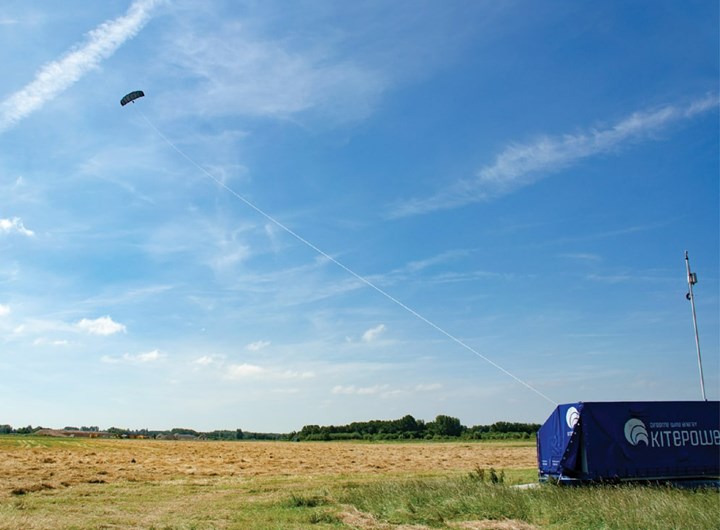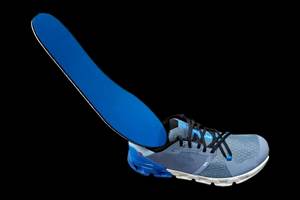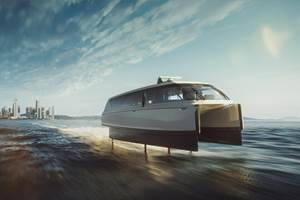
Photo Credit, all images: Kitepower
Founded by researchers at Delft University of Technology (TU Delft, Netherlands), startup company Kitepower is working toward development and deployment of a kite-based, airborne wind energy (AWE) system, designed to be a mobile, low-footprint renewable energy solution.
The researchers’ first 20-kilowatt (kW) proof of concept was demonstrated in 2007, and the company was officially co-founded by researchers Johannes Peschel and Roland Schmehl in 2016. This year, Kitepower raised well over its €700,000 target in a recent crowdfunding campaign aiming to commercialize the company’s Falcon model. Falcon is a 100-kW AWE system said to be able to generate 450 megawatt-hours (MWh) of electricity per year, enough to power 150 homes.
Kitepower’s patented technology, in development at TU Delft since the 1990s, features an airborne kite and control unit that are tethered to a fixed ground station, which converts the mechanical energy of the kite into electrical power. The control unit controls the trajectory of the kite in the air — the kite is designed to fly in a figure-eight pattern to achieve maximum pulling force and mechanical energy — and the ground station also serves to reel the kite and tether in and out as needed.
The kite features an inflatable membrane wing attached to a rigid, tube-shaped fiberglass composite skeleton, a combination designed to maximize strength with light weight. According to Peschel, carbon fiber was also considered but fiberglass was chosen for more flexibility while achieving the required strength. The skeleton is made up of 12 hollow tube structures connected via custom-made aluminum connectors. The fiberglass composite tubes are designed by Kitepower, manufactured by an external partner and then assembled by the Kitepower team.
Lying flat, the fully assembled kite measures 60 square meters, and achieves an average flight speed of about 110 kilometers per hour when airborne. The kite is held aloft by a tether made from ultra-high molecular weight polyethylene (UHMWPE) Dyneema fibers.

The Kitepower system is said to require only one square meter of ground space for the control unit, and can be easily integrated into existing power grids. Ultimately, the solution is designed to provide a renewable energy solution that, compared to solar or wind energy, is more easily installed and transported, uses fewer materials to manufacture and takes up less physical space. Depending on wind conditions, the system can also generate electricity day and night, regardless of weather conditions.
According to Peschel, Kitepower currently operates in shared factory space in Delft, as the team focuses on a short-term pilot project with its first Falcon model. In 2023, after achieving EU regulatory certifications for the technology, the company plans to begin scale-up of its operations in order to begin producing 100-kW Falcon models for permanent installation by third-party customers by 2024. Current energy company partners include Greener (Amsterdam, Netherlands), Enerwhere Sustainable Energy (Dubai, United Arab Emirates) and Veida Renewables (Moorabin, Australia). Once Falcon models are proven to be successful, Kitepower aims to scale up the technology further to the ultimate goal: a utility-scale, 500-kW Eagle model.
Related Content
Nanomaterials optimize performance of space-ready carbon fiber composite panels
A recent ESA project led by Adamant Composites aimed to mature nanomaterial-enhanced CFRP for lighter weight, more thermally and electrically conductive materials for manufacturing satellite structures.
Read MorePrefabricated composite panels, joining system ease catamaran construction
New Zealand-based G&T Marine reduces assembly and construction time with ATL Composites’ composite DuFLEX panels.
Read MoreRunning shoe insoles get a lift with thermoplastic fiberglass tapes
FlexSpring insoles take advantage of unidirectional, continuous fiberglass and thermoplastics to enable next-level performance for the everyday runner.
Read MoreCarbon fiber composite hydrofoils to enable “world’s fastest” electric ferry
The Candela P-12 Shuttle, set to launch in Stockholm, Sweden, in 2023, will incorporate lightweight composites and automated manufacturing to combine speed, passenger comfort and energy efficiency.
Read MoreRead Next
From the CW Archives: The tale of the thermoplastic cryotank
In 2006, guest columnist Bob Hartunian related the story of his efforts two decades prior, while at McDonnell Douglas, to develop a thermoplastic composite crytank for hydrogen storage. He learned a lot of lessons.
Read MoreCW’s 2024 Top Shops survey offers new approach to benchmarking
Respondents that complete the survey by April 30, 2024, have the chance to be recognized as an honoree.
Read MoreComposites end markets: Energy (2024)
Composites are used widely in oil/gas, wind and other renewable energy applications. Despite market challenges, growth potential and innovation for composites continue.
Read More

.jpg;width=70;height=70;mode=crop)

























